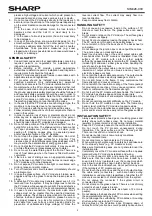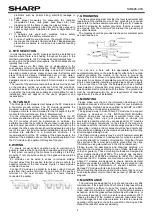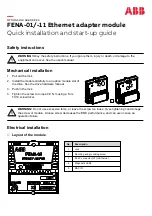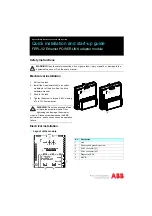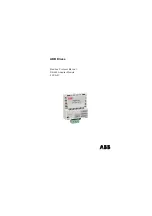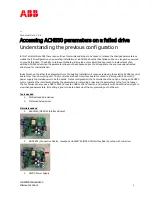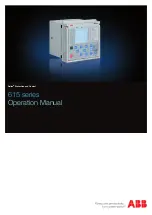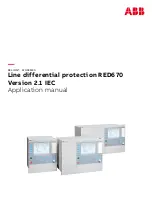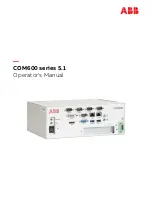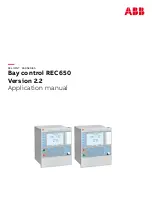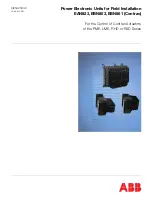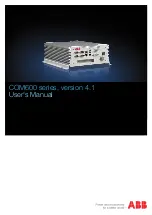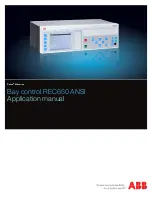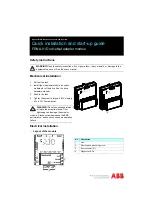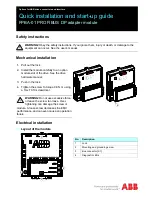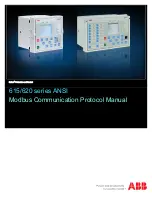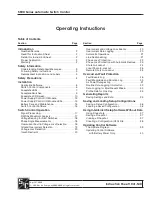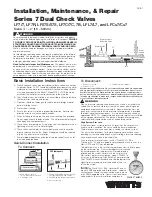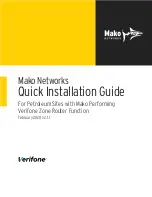
SIM426-009
2
produce high voltage and current which could present an
increased hazard and may cause serious injury or death.
5.
Do not connect the PV modules directly to the loads such
as
motor since the variation of the output power depending
on the solar irradiation causes damage for the connected
motor.
1: In the case of a brushless motor, the lock function
becomes active and the hall IC is most likely to be
damaged.
2: In the case of a brush type motor, the coil is most likely
to be damaged.
6.
In case of snow build-up, snow would slide easier on the
smooth surface of the module than other parts of the roof.
Snow may suddenly slide, fall off the roof and hit nearby
objects/areas. Take preventive measures (e.g. snow
stopper) when there is possible risk such case would cause
an injury or a damage.
GENERAL SAFETY
1.
Consult local codes and other applicable laws concerning
required permits on regulations for installation and
inspection requirements.
2.
Before installing a PV module, contact appropriate
authorities to determine permit, installation and inspection
requirements that should be followed.
3.
Install PV modules and ground frames in accordance with
applicable rules and regulations.
4.
PV modules should be installed and maintained by
qualified personnel. Only installer/servicer personnel
should have access to the PV module installation site.
5.
No matter where the PV modules are installed, either roof
mounted construction or any other type of structures above
the ground, appropriate safety practices should be followed
and required safety equipment should be used in order to
avoid possible safety hazards. Note that the installation of
some PV modules on roofs may require the addition of
fireproofing, depending on local building/fire codes.
6.
In the case that the PV modules are non-integral type, the
module is to be mounted over a fire resistant roof.
7.
Use PV modules with the same cell size within series.
8.
Follow all safety precautions of other components that are
used in the system.
9.
In order to avoid a risk of injury or electrical shock, do not
allow anyone to approach the PV module if the person
has little knowledge on PV module or on the measures that
should be taken when PV modules are damaged.
10. Do not shade portions of the PV module surface from the
sunlight for a long time. The shaded cell may become hot
(hot spot phenomenon) which results in solder joints
peeling off.
Shading causes drop in generated power
and/or operation failure of the PV modules.
11. Do not clean the glass surface with chemicals. Do not let
water collect on the glass surface for a long time. This
creates a risk of white efflorescence (glass disease) which
may result in the deterioration of energy generation.
12. Do not install the PV module horizontally. It may cause dirt
or white efflorescence (glass disease) due to water.
13. Do not cover the water drain gap of the frame. There is a
risk of frost damage when the frame is filled with water
cumulation.
14. If there is a risk of sliding snow, an appropriate measure
has to be taken so that PV module frames on lower edge
of PV modules will not be damaged.
15. Do not expose PV module to sunlight concentrated with
mirrors, lenses or similar means.
16. Turn off inverters and circuit breakers immediately, should
a problem occur.
17. In case the glass surface of a PV module is broken, wear
goggles and tape the glass to keep the broken pieces in
place.
18. A defective PV module may generate power even if it is
removed from the system. It may be dangerous to handle
the PV module while exposed to sunlight. Place a defective
PV module in a carton so PV cells are completely shaded.
19. In case of series connection, the maximum open circuit
voltage must not be greater than the specified maximum
system voltage. The voltage is proportional to the number
of series. In case of parallel connection, please be sure to
take proper measure (e.g. fuse for protection of module
and cable from over current, and/or blocking diode for
prevention of unbalanced strings voltage) to block the
reverse current flow. The current may easily flow in a
reverse direction
.
20. Keep modules away from children.
HANDLING SAFETY
1.
Do not cause an excessive load on the surface of PV
module or twist the frame. The glass surface can easily
break.
2.
Do not stand or step on the PV module. The surface glass
of PV module is slippery.
3.
Do not hit or put excessive load on the glass or back sheet.
The PV cell is very thin and can be easily broken.
4.
Do not scratch or hit at the back sheet. The back sheet is
vulnerable.
5.
Do not damage the junction box or do not pull the cables.
The junction box can crack and break.
6.
Never touch junction box or the end of output cables with
bare hands when the PV module is irradiated. Cover the
surface of PV module with cloth or other suitable
sufficiently opaque material to isolate the PV module from
incident light and wear rubber gloves when handling the
wires to avoid electric shock.
7.
Do not scratch the output cable or bend it with force. The
insulation of output cable can break and may result in
electricity leakage or shock.
8.
Do not pull the output cable excessively. The output cable
may unplug and cause electricity leakage or shock.
9.
Do not drill holes in the frame. It may compromise the
frame strength and cause corrosion.
10. Do not scratch the insulation coating of the frame (except
for grounding connection). It may cause corrosion of the
frame or compromise the framework strength.
11. Do not touch the PV module with bare hands. The frame of
PV module has sharp edges and may cause injury.
12. Do not drop PV module or allow objects to fall down on the
PV module.
13. Do not concentrate sunlight artificially on the PV module.
14. Do not hold the PV module on one side. The frame may
bend or twist. Hold the PV module at opposite sides.
15.
Do not touch the anti-reflective coated glass since finger
prints and/or stains can be easily left on the glass surface.
INSTALLATION SAFETY
1.
Always wear protective head gear, insulating gloves and
safety shoes (with rubber soles). Do not wear metallic
jewellery to prevent electric shock during installation.
2.
Keep the PV module packed in the carton until installation.
3.
Do not touch the PV module unnecessarily during
installation. The glass surface and the frames get hot.
There is a risk of burn, or electric shock.
4.
Do not work under rain, snow or windy conditions.
5.
Use dry insulated tools.
6.
Do not drop tools or hard objects on PV modules
7.
When working at heights, wear a safety belt and take care
not to drop any items (e.g., PV module or tools).
8.
Make sure flammable gases are not generated near the
installation site.
9.
Completely cover the PV module surface with an opaque
material during PV module installation and wiring.
10. Plug in the connector tight and ensure the wiring work.
Make sure that the connectors have been locked by a
snap-in latch. Any treatments over the connectors which
may allow to unlock the snap-in latch shall not be done.
11. Due to the risk of electrical shock, do not perform any work
if the terminals of PV module are wet.
12. Do not touch the junction box and the end of output cables,
the cable ends (connectors) , with bare hands during
installation or under sunlight, regardless of whether the PV
module is connected to or disconnected from the system.
13. Do not unplug the connector if the system circuit is
connected to a load.
14. Do not stomp on the glass at work. There is a risk of injury
or electric shock if glass is broken.
15. Do not work alone (always work as a team of 2 or more
people).
16. Do not damage the back sheet of PV modules when setting
the equipotential bonding by bolts.
17. Do not damage the surrounding PV modules or mounting
structure when replacing a PV module.
18. Bind cables by the insulation locks. Drooping down of
cables from the junction box could possibly cause various


